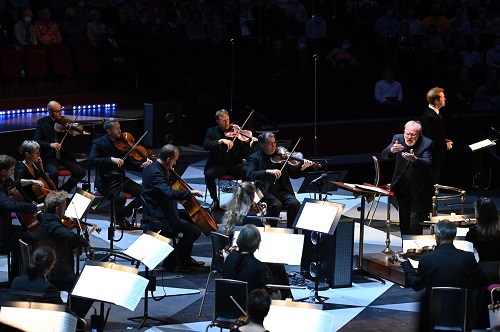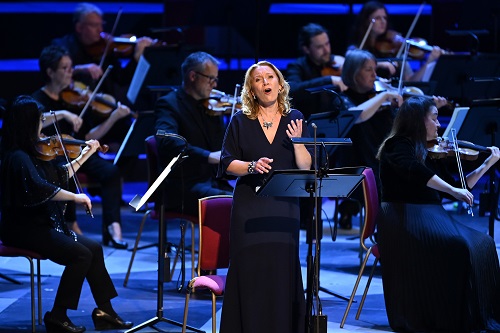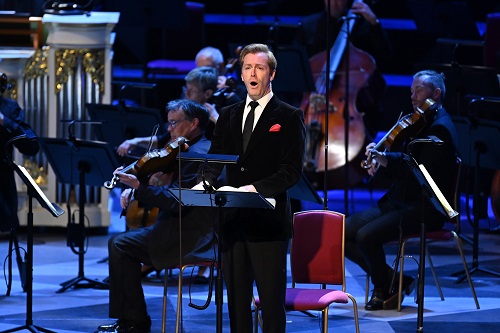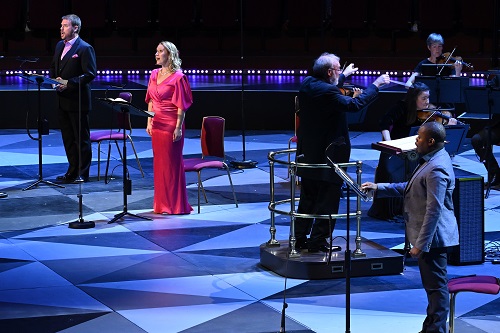When Stravinsky’s ‘one-act ballet with songs’, Pulcinella,was first performed in 1920 – by Diaghilev’s Ballet Russes, with choreography by Léonide Massine and designs by Pablo Picasso – the music was described as being ‘after Giovanni Battista Pergolesi’. Now we know that alongside a few of Pergolesi’s scores, Stravinsky also affectionately plundered music by the less well-known Domenico Gallo, Count Unico Wilhelm van Wassenaer and Carlo Ignazio Monza. But, the BBC Scottish Symphony Orchestra’s decision to preface their Proms performance of Stravinsky’s complete ballet score with Pergolesi’s perennially popular Stabat mater was an attractive one, offering the opportunity to compare the composers’ contrasting exploitation and creative revisioning of the essence of Baroque style and idiom.
The Stabat mater text presents the Feast of the Seven Sorrows of the Blessed Virgin Mary which is celebrated annually on the Friday after Passion Sunday. Pergolesi’s own setting was commissioned in 1736 by the Brotherhood of the Vergine dei dolori, to whose monastery just outside Naples the composer had retreated in the early part of that year. He died there a few weeks later, aged just 26 years old, having completed the Stabat mater which immediately became well-known and widely published.
One problem arising from the frequent reprinting of the work was the tendency of editors and publishers to alter the vocal and instrumental forces. Some such as Joseph von Eybler added men’s voices and wind instruments; Ignatz Ritter von Seyfried thought trombones appropriate. Presumably, given the liturgical context, the work was originally sung by a boy soprano and alto castrato, but subsequently it became common for the Stabat mater to be performed by SATB soloists and choir accompanied by expansive instrumental forces. The BBCSSO went back to basics, employing just a small string ensemble and organ to accompany soprano Carolyn Sampson and countertenor Tim Mead, under the baton of Martyn Brabbins.

One positive outcome of this economy was that the personal, intimate nature of the work was restored, and both soloists and instrumentalists favoured a prevailing delicacy and restraint which were, however, deeply expressive. There were passages, though, where Sampson’s silvery, crystalline shine and the fuller, sweet warmth of Mead’s countertenor did not always blend persuasively, though this may have been exacerbated by the decision to position the soloists 25 feet apart from each other at the front of the extended platform, with the BBCSSO musicians sparsely scattered behind them. There was also some difference in the singers’ approach to the ornamentation of the vocal lines. Sampson’s trills were tight and bright, Mead’s slightly looser and integrated into the lyricism of the phrasing. Mead had a tendency to elongate the rising appoggiaturas, whereas the soprano adopted a light toucher to the expressive decoration.
Despite these minor discrepancies, this was a profoundly communicative Stabat mater. The familiar bass tread which opens the work seemed to have a slight spring in its step, forming a nice contrast to the pointed suspensions of the reedy organ (Michael Bawtree) and strings (led by Laura Samuel). Maintaining ensemble and collective style can’t have been easy for the dispersed musicians but Brabbins’ guidance was evidently both clear and precise, and Samuel was a characteristically committed and demonstrative leader. The ensemble textures were by turns transparent and emphatic, as the music required, and there was often a lovely buoyancy, as in ‘Quae moerebat et dolebat’ – where Pergolesi seems to overlook the text’s depiction of Mary beholding the torment of her crucified son and the alto soloist sounds more like one of Handel’s over-confident lovestruck heroes than an anguished narrator.

The beautiful violin phrasing of ‘Vidit suum dulcem natum’ heightened the pathos of Christ’s death as his aggrieved mother looks on, and Sampson’s wonderfully expressive pianissimo and diminuendo, “dum emisit spiritum” (as he gave up his spirit), was made even more poignant by the violins’ fragile sotto voce pulsing, evoking the final fading breathes of Christ. Just occasionally I found the violins’ articulation a little too dramatic with exaggerated accents and dynamic contrasts, as in the soprano’s first aria, ‘Cujus animam gementeem’, where Sampson’s taut repeated trills ( “pertransivit gladius”, an image of the sword which has passed through Mary’s heart), each one marked by an emphatic appoggiatura, were technically impressive but robbed the music of some of its simplicity.
I thought, too, that Brabbins eked out some of the Largo movements, such as ‘Quis est homo’, though this did offer us an opportunity to compare the soloists’ messa di voce – Sampson’s crescendo seemed more dramatic and urgent, Mead’s pitch more focused and the resolving dissonances more squeezed for anguish – and there was an exquisite vocal interchange at the close, the soprano’s expression of humanity’s weeping (“in tanto supplicio”) contrasting with the alto’s image, pitched an octave lower, of a mother’s empathy with her son’s suffering (“dolentum cum filio”), and powerfully communicating pain experienced and shared. The deliberateness of ‘Quando corpus’ did seem to me, however, to lessen the poetry of the burning dissonances and the violins’ doloroso tears.

The expressive beauties were many, though. The elegance of ‘Eja mater, fons amoris’ was deepened by the soft warmth of Mead’s low countertenor, which strengthened the sincerity of the plea to Mary to touch man’s spirit, and by the strings’ judicious contrast of spiccato and legato, loud and soft. The contrapuntal ‘Fac ut ardeat’ had a compelling forward momentum which, together with the strong bass imitation and marked string crotchets, conveyed the urgency of the appeal, ‘Make me feel’. The violins’ relaxed lyricism at the start of ‘Sancta mater’ again seemed a little out of kilter with the spirit of the text, but here it conveyed Mary’s power to bestow redemptive grace, and the subsequent chromatic sighs and harmonic shifts conveyed the mournful mood. And, in Mead’s final aria, ‘Fac ut portem Christi mortem’, the strings’ taut dotted rhythms contrasted effectively with the extended, decorative lyricism of the vocal line and the images of Christ’s wounds (“plagas recolere”) and Mary’s love for her son (“ob amorem filii”).
In the eighteenth century there were some who criticised Pergolesi’s writing for its lack of spirituality, complaining that the Stabat mater was too reminiscent of his buffo operas, but others, including Jean-Jacques Rousseau and Charles Burney, found heights of purity and piety in the composer’s writing. This performance put me firmly in the latter camp.
Stravinsky’s ‘possession’ of his selected eighteenth-century sources involves not only strikingly economical reorientation by rhythmic and timbral means but also a radical adjustment of the relationship between music and movement, voices and instruments, and their respective function in the balletic narrative. One of the real strengths of Brabbins’ interpretation of Pulcinella was his realisation of the music’s sense of space and gesture: the instrumental motifs really did conjure kinetic shapes and energies, the shifts of gear and mood were persuasively crafted, and the elements of the whole were beautifully balanced. There was a prevailing vitality which seemed apt for this tale of the wooing and wiles, roguery and ‘resurrection’ of the irrepressible Pulcinella.

It was also a joy to hear the ballet complete, rather than in the form of the more frequently performed 1922 concert suite that comprises only eleven of the ballet’s eighteen movements. The BBCSSO captured every ounce of the music’s elegance, wit and robustness. The vigour that I sometimes found a little out of place in the Stabat mater, was here just perfect: all was crisp, clean and lithe, and there was some terrifically communicative playing from the concertante string group, led with impressive focus and eloquence by Samuel. Ever-changing colours, textures and tempi – a perky woodwind Scherzino slipping into a refined Andantino melodising of flute and violin, for example, the latter then blooming into a cheekily rumbustious Allegro – cohered into a musical narrative which seemed to tell an eventful tale and to compel one, if not to dance oneself, then to imagine a theatre stage with its busy comings and goings. The triple-time Allegro assai was a delight, all scurrying woodwind, racing strings, pinging bass off-beats and a thrilling rhythmic verve which recalled the pulsing power of Stravinsky’s three pre-war Ballet Russe ballets.
The soprano aria, ‘Contento forse vivere’, lies a little low for Sampson, and lack of weight at the bottom made for a slightly uncomfortable contrast with the sudden flashes of brightness when phrases leapt high only to fall swiftly again. But, ‘Se tu m’ami’, plays to her strengths, and Sampson’s silky legato phrases conveyed all of the solipsist self-indulgence of the adored Sylvia, whose refusal to swear loyalty to her worshipful shepherd causes suffering that could not be assuaged by the soft, coy string concertante and beguiling oboe solo. And, despite the languorous pace Brabbins adopted for the trio, ‘Sento dire no’ncè pace’, the three soloists blended comfortingly, Sampson’s gleaming heights intensifying the loss of peace of which they sing, “Sento dire no’ncè cor,/ Ma’ cchiù pette”. There were flashes of fire, too, in the fierce descents of the subsequent duet in which soprano and tenor tell of the many, many deceits – “E tant’antre malizie” – cruelly practised by those women who keep one hundred hearts dangling on a string.
Brabbins did, once again, seem inclined to adopt very stately tempos for some of the slow movements. The tenor’s Serenata, ‘Mentre l’erbetta’, lacked the sort of lilting charm that might have lifted the tone from minor-key despondency and gloom, for whereas Pergolesi has a tendency to breeze cheerily through anguished texts, Stravinsky here makes images of lambs grazing on fresh grass and shepherdesses singing amid leafy groves, sound rather mournful – a slightly faster tempo would have given gestures such as the punchy bass offbeats a more waggish lightness. The beautiful oboe solo soothed, however, and Benjamin Hulett’s tenor was sweetening, supported by warm concertante strings. In contrast, Brabbins didn’t let Hulett off the hook in ‘Una te fallan zemprecce’, keeping the tempo racing through the tenor’s relentless – and brilliantly delivered – tongue-twisting patter.
Bass-baritone Simon Shibambu similarly coped impressively with the registral expanse that Stravinsky demands the soloist to negotiate in ‘Con queste paroline’ and conveyed both the intensity of the passion felt and the anxious fear that such heights of ecstasy may be temporary, withdrawn at the loved one’s whim. And, though the penultimate movement, an imitative slow minuet for the three voices, lamented a languishing heart, it was that resourceful scoundrel, Pulcinella, who had the last word in the cheerful concluding Allegro assai, magically defeating his adversaries and winning the hand of his Pimpinella with a nonchalant shrug.
This concert is available on BBC Sounds for 28 days following the performance.
Claire Seymour
Carolyn Sampson (soprano), Tim Mead (countertenor), Benjamin Hulett (tenor), Simon Shibambu (bass-baritone), BBC Scottish Symphony Orchestra, Martyn Brabbins (conductor)
Royal Albert Hall, London; Friday 6th August 2021.
ABOVE: Martyn Brabbins (c) BBC/Chris Christodoulou